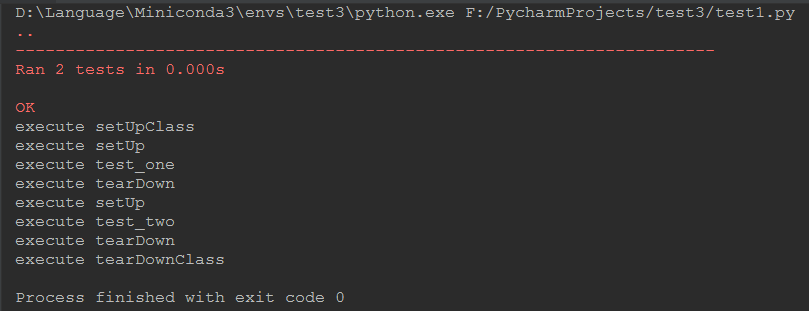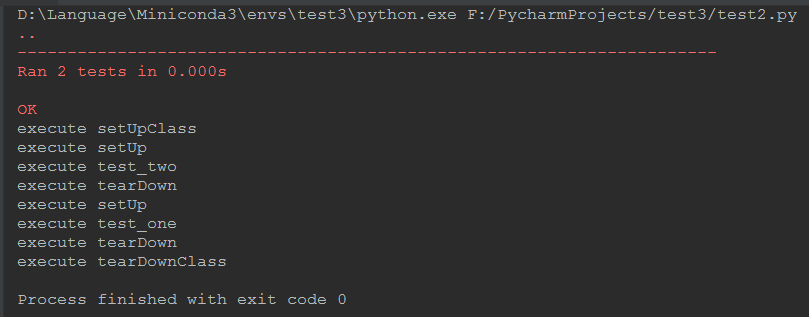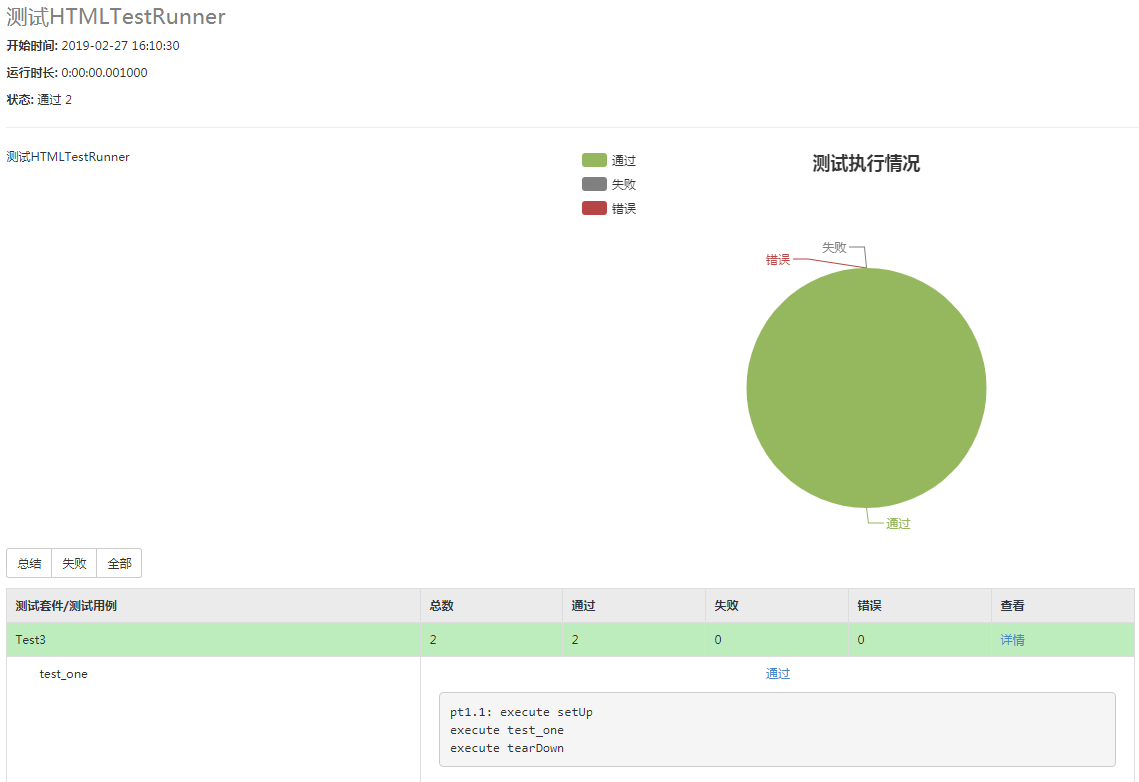一、直接使用TestCase
注意所有测试方法都需要以test开头。代码如下:
import unittest class Test1(unittest.TestCase): @classmethod def setUpClass(self): print("execute setUpClass") @classmethod def tearDownClass(self): print("execute tearDownClass") def setUp(self): print("execute setUp") def tearDown(self): print("execute tearDown") def test_one(self): print('execute test_one') self.assertTrue('FOO'.isupper()) def test_two(self): print('execute test_two') if __name__ == '__main__': unittest.main()
执行如下:

二、使用TestSuite
直接写TestCase执行时是按字母排序的顺序执行的,如果要设定测试用例的执行先后顺序则需要将TestCase封装到TestSuite。代码如下:
import unittest class Test2(unittest.TestCase): @classmethod def setUpClass(self): print("execute setUpClass") @classmethod def tearDownClass(self): print("execute tearDownClass") def setUp(self): print("execute setUp") def tearDown(self): print("execute tearDown") def test_one(self): print('execute test_one') self.assertTrue('FOO'.isupper()) def test_two(self): print('execute test_two') if __name__ == '__main__': suite = unittest.TestSuite() # Test2是要测试的类名,test_two是要执行的测试方法 suite.addTest(Test2("test_two")) suite.addTest(Test2("test_one")) runner = unittest.TextTestRunner() runner.run(suite)
执行如下,可以看到先添加的test_two先执行:

三、使用HTMLTestRunner
我们可能还会希望生成一个简单的HTML报告,可使用HTMLTestRunner实现。但pypi和官网上最新的都是只支持python2.x的0.8.2版本。可将以下代码自行保存成HTMLTestRunner.py放到自己项目目录下

# -*- coding: utf-8 -*- """ A TestRunner for use with the Python unit testing framework. It generates a HTML report to show the result at a glance. The simplest way to use this is to invoke its main method. E.g. import unittest import HTMLTestRunner ... define your tests ... if __name__ == '__main__': HTMLTestRunner.main() For more customization options, instantiates a HTMLTestRunner object. HTMLTestRunner is a counterpart to unittest's TextTestRunner. E.g. # output to a file fp = file('my_report.html', 'wb') runner = HTMLTestRunner.HTMLTestRunner( stream=fp, title='My unit test', description='This demonstrates the report output by HTMLTestRunner.' ) # Use an external stylesheet. # See the Template_mixin class for more customizable options runner.STYLESHEET_TMPL = '<link rel="stylesheet" href="my_stylesheet.css" type="text/css">' # run the test runner.run(my_test_suite) ------------------------------------------------------------------------ Copyright (c) 2004-2007, Wai Yip Tung All rights reserved. Redistribution and use in source and binary forms, with or without modification, are permitted provided that the following conditions are met: * Redistributions of source code must retain the above copyright notice, this list of conditions and the following disclaimer. * Redistributions in binary form must reproduce the above copyright notice, this list of conditions and the following disclaimer in the documentation and/or other materials provided with the distribution. * Neither the name Wai Yip Tung nor the names of its contributors may be used to endorse or promote products derived from this software without specific prior written permission. THIS SOFTWARE IS PROVIDED BY THE COPYRIGHT HOLDERS AND CONTRIBUTORS "AS IS" AND ANY EXPRESS OR IMPLIED WARRANTIES, INCLUDING, BUT NOT LIMITED TO, THE IMPLIED WARRANTIES OF MERCHANTABILITY AND FITNESS FOR A PARTICULAR PURPOSE ARE DISCLAIMED. IN NO EVENT SHALL THE COPYRIGHT OWNER OR CONTRIBUTORS BE LIABLE FOR ANY DIRECT, INDIRECT, INCIDENTAL, SPECIAL, EXEMPLARY, OR CONSEQUENTIAL DAMAGES (INCLUDING, BUT NOT LIMITED TO, PROCUREMENT OF SUBSTITUTE GOODS OR SERVICES; LOSS OF USE, DATA, OR PROFITS; OR BUSINESS INTERRUPTION) HOWEVER CAUSED AND ON ANY THEORY OF LIABILITY, WHETHER IN CONTRACT, STRICT LIABILITY, OR TORT (INCLUDING NEGLIGENCE OR OTHERWISE) ARISING IN ANY WAY OUT OF THE USE OF THIS SOFTWARE, EVEN IF ADVISED OF THE POSSIBILITY OF SUCH DAMAGE. """ # URL: http://tungwaiyip.info/software/HTMLTestRunner.html __author__ = "Wai Yip Tung" __version__ = "0.9.1" """ Change History Version 0.9.1 * 用Echarts添加执行情况统计图 (灰蓝) Version 0.9.0 * 改成Python 3.x (灰蓝) Version 0.8.3 * 使用 Bootstrap稍加美化 (灰蓝) * 改为中文 (灰蓝) Version 0.8.2 * Show output inline instead of popup window (Viorel Lupu). Version in 0.8.1 * Validated XHTML (Wolfgang Borgert). * Added description of test classes and test cases. Version in 0.8.0 * Define Template_mixin class for customization. * Workaround a IE 6 bug that it does not treat <script> block as CDATA. Version in 0.7.1 * Back port to Python 2.3 (Frank Horowitz). * Fix missing scroll bars in detail log (Podi). """ # TODO: color stderr # TODO: simplify javascript using ,ore than 1 class in the class attribute? import datetime import sys import io import time import unittest from xml.sax import saxutils # ------------------------------------------------------------------------ # The redirectors below are used to capture output during testing. Output # sent to sys.stdout and sys.stderr are automatically captured. However # in some cases sys.stdout is already cached before HTMLTestRunner is # invoked (e.g. calling logging.basicConfig). In order to capture those # output, use the redirectors for the cached stream. # # e.g. # >>> logging.basicConfig(stream=HTMLTestRunner.stdout_redirector) # >>> class OutputRedirector(object): """ Wrapper to redirect stdout or stderr """ def __init__(self, fp): self.fp = fp def write(self, s): self.fp.write(s) def writelines(self, lines): self.fp.writelines(lines) def flush(self): self.fp.flush() stdout_redirector = OutputRedirector(sys.stdout) stderr_redirector = OutputRedirector(sys.stderr) # ---------------------------------------------------------------------- # Template class Template_mixin(object): """ Define a HTML template for report customerization and generation. Overall structure of an HTML report HTML +------------------------+ |<html> | | <head> | | | | STYLESHEET | | +----------------+ | | | | | | +----------------+ | | | | </head> | | | | <body> | | | | HEADING | | +----------------+ | | | | | | +----------------+ | | | | REPORT | | +----------------+ | | | | | | +----------------+ | | | | ENDING | | +----------------+ | | | | | | +----------------+ | | | | </body> | |</html> | +------------------------+ """ STATUS = { 0: u'通过', 1: u'失败', 2: u'错误', } DEFAULT_TITLE = 'Unit Test Report' DEFAULT_DESCRIPTION = '' # ------------------------------------------------------------------------ # HTML Template HTML_TMPL = r"""<?xml version="1.0" encoding="UTF-8"?> <!DOCTYPE html PUBLIC "-//W3C//DTD XHTML 1.0 Strict//EN" "http://www.w3.org/TR/xhtml1/DTD/xhtml1-strict.dtd"> <html xmlns="http://www.w3.org/1999/xhtml"> <head> <title>%(title)s</title> <meta name="generator" content="%(generator)s"/> <meta http-equiv="Content-Type" content="text/html; charset=UTF-8"/> <link href="http://cdn.bootcss.com/bootstrap/3.3.0/css/bootstrap.min.css" rel="stylesheet"> <script src="https://cdn.bootcss.com/echarts/3.8.5/echarts.common.min.js"></script> <!-- <script type="text/javascript" src="js/echarts.common.min.js"></script> --> %(stylesheet)s </head> <body> <script language="javascript" type="text/javascript"><!-- output_list = Array(); /* level - 0:Summary; 1:Failed; 2:All */ function showCase(level) { trs = document.getElementsByTagName("tr"); for (var i = 0; i < trs.length; i++) { tr = trs[i]; id = tr.id; if (id.substr(0,2) == 'ft') { if (level < 1) { tr.className = 'hiddenRow'; } else { tr.className = ''; } } if (id.substr(0,2) == 'pt') { if (level > 1) { tr.className = ''; } else { tr.className = 'hiddenRow'; } } } } function showClassDetail(cid, count) { var id_list = Array(count); var toHide = 1; for (var i = 0; i < count; i++) { tid0 = 't' + cid.substr(1) + '.' + (i+1); tid = 'f' + tid0; tr = document.getElementById(tid); if (!tr) { tid = 'p' + tid0; tr = document.getElementById(tid); } id_list[i] = tid; if (tr.className) { toHide = 0; } } for (var i = 0; i < count; i++) { tid = id_list[i]; if (toHide) { document.getElementById('div_'+tid).style.display = 'none' document.getElementById(tid).className = 'hiddenRow'; } else { document.getElementById(tid).className = ''; } } } function showTestDetail(div_id){ var details_div = document.getElementById(div_id) var displayState = details_div.style.display // alert(displayState) if (displayState != 'block' ) { displayState = 'block' details_div.style.display = 'block' } else { details_div.style.display = 'none' } } function html_escape(s) { s = s.replace(/&/g,'&'); s = s.replace(/</g,'<'); s = s.replace(/>/g,'>'); return s; } /* obsoleted by detail in <div> function showOutput(id, name) { var w = window.open("", //url name, "resizable,scrollbars,status,width=800,height=450"); d = w.document; d.write("<pre>"); d.write(html_escape(output_list[id])); d.write(" "); d.write("<a href='javascript:window.close()'>close</a> "); d.write("</pre> "); d.close(); } */ --></script> <div id="div_base"> %(heading)s %(report)s %(ending)s %(chart_script)s </div> </body> </html> """ # variables: (title, generator, stylesheet, heading, report, ending, chart_script) ECHARTS_SCRIPT = """ <script type="text/javascript"> // 基于准备好的dom,初始化echarts实例 var myChart = echarts.init(document.getElementById('chart')); // 指定图表的配置项和数据 var option = { title : { text: '测试执行情况', x:'center' }, tooltip : { trigger: 'item', formatter: "{a} <br/>{b} : {c} ({d}%%)" }, color: ['#95b75d', 'grey', '#b64645'], legend: { orient: 'vertical', left: 'left', data: ['通过','失败','错误'] }, series : [ { name: '测试执行情况', type: 'pie', radius : '60%%', center: ['50%%', '60%%'], data:[ {value:%(Pass)s, name:'通过'}, {value:%(fail)s, name:'失败'}, {value:%(error)s, name:'错误'} ], itemStyle: { emphasis: { shadowBlur: 10, shadowOffsetX: 0, shadowColor: 'rgba(0, 0, 0, 0.5)' } } } ] }; // 使用刚指定的配置项和数据显示图表。 myChart.setOption(option); </script> """ # variables: (Pass, fail, error) # ------------------------------------------------------------------------ # Stylesheet # # alternatively use a <link> for external style sheet, e.g. # <link rel="stylesheet" href="$url" type="text/css"> STYLESHEET_TMPL = """ <style type="text/css" media="screen"> body { font-family: Microsoft YaHei,Consolas,arial,sans-serif; font-size: 80%; } table { font-size: 100%; } pre { white-space: pre-wrap;word-wrap: break-word; } /* -- heading ---------------------------------------------------------------------- */ h1 { font-size: 16pt; color: gray; } .heading { margin-top: 0ex; margin-bottom: 1ex; } .heading .attribute { margin-top: 1ex; margin-bottom: 0; } .heading .description { margin-top: 2ex; margin-bottom: 3ex; } /* -- css div popup ------------------------------------------------------------------------ */ a.popup_link { } a.popup_link:hover { color: red; } .popup_window { display: none; position: relative; left: 0px; top: 0px; /*border: solid #627173 1px; */ padding: 10px; /*background-color: #E6E6D6; */ font-family: "Lucida Console", "Courier New", Courier, monospace; text-align: left; font-size: 8pt; /* 500px;*/ } } /* -- report ------------------------------------------------------------------------ */ #show_detail_line { margin-top: 3ex; margin-bottom: 1ex; } #result_table { 99%; } #header_row { font-weight: bold; color: #303641; background-color: #ebebeb; } #total_row { font-weight: bold; } .passClass { background-color: #bdedbc; } .failClass { background-color: #ffefa4; } .errorClass { background-color: #ffc9c9; } .passCase { color: #6c6; } .failCase { color: #FF6600; font-weight: bold; } .errorCase { color: #c00; font-weight: bold; } .hiddenRow { display: none; } .testcase { margin-left: 2em; } /* -- ending ---------------------------------------------------------------------- */ #ending { } #div_base { position:absolute; top:0%; left:5%; right:5%; auto; height: auto; margin: -15px 0 0 0; } </style> """ # ------------------------------------------------------------------------ # Heading # HEADING_TMPL = """ <div class='page-header'> <h1>%(title)s</h1> %(parameters)s </div> <div style="float: left;50%%;"><p class='description'>%(description)s</p></div> <div id="chart" style="50%%;height:400px;float:left;"></div> """ # variables: (title, parameters, description) HEADING_ATTRIBUTE_TMPL = """<p class='attribute'><strong>%(name)s:</strong> %(value)s</p> """ # variables: (name, value) # ------------------------------------------------------------------------ # Report # REPORT_TMPL = u""" <div class="btn-group btn-group-sm"> <button class="btn btn-default" onclick='javascript:showCase(0)'>总结</button> <button class="btn btn-default" onclick='javascript:showCase(1)'>失败</button> <button class="btn btn-default" onclick='javascript:showCase(2)'>全部</button> </div> <p></p> <table id='result_table' class="table table-bordered"> <colgroup> <col align='left' /> <col align='right' /> <col align='right' /> <col align='right' /> <col align='right' /> <col align='right' /> </colgroup> <tr id='header_row'> <td>测试套件/测试用例</td> <td>总数</td> <td>通过</td> <td>失败</td> <td>错误</td> <td>查看</td> </tr> %(test_list)s <tr id='total_row'> <td>总计</td> <td>%(count)s</td> <td>%(Pass)s</td> <td>%(fail)s</td> <td>%(error)s</td> <td> </td> </tr> </table> """ # variables: (test_list, count, Pass, fail, error) REPORT_CLASS_TMPL = u""" <tr class='%(style)s'> <td>%(desc)s</td> <td>%(count)s</td> <td>%(Pass)s</td> <td>%(fail)s</td> <td>%(error)s</td> <td><a href="javascript:showClassDetail('%(cid)s',%(count)s)">详情</a></td> </tr> """ # variables: (style, desc, count, Pass, fail, error, cid) REPORT_TEST_WITH_OUTPUT_TMPL = r""" <tr id='%(tid)s' class='%(Class)s'> <td class='%(style)s'><div class='testcase'>%(desc)s</div></td> <td colspan='5' align='center'> <!--css div popup start--> <a class="popup_link" onfocus='this.blur();' href="javascript:showTestDetail('div_%(tid)s')" > %(status)s</a> <div id='div_%(tid)s' class="popup_window"> <pre>%(script)s</pre> </div> <!--css div popup end--> </td> </tr> """ # variables: (tid, Class, style, desc, status) REPORT_TEST_NO_OUTPUT_TMPL = r""" <tr id='%(tid)s' class='%(Class)s'> <td class='%(style)s'><div class='testcase'>%(desc)s</div></td> <td colspan='5' align='center'>%(status)s</td> </tr> """ # variables: (tid, Class, style, desc, status) REPORT_TEST_OUTPUT_TMPL = r"""%(id)s: %(output)s""" # variables: (id, output) # ------------------------------------------------------------------------ # ENDING # ENDING_TMPL = """<div id='ending'> </div>""" # -------------------- The end of the Template class ------------------- TestResult = unittest.TestResult class _TestResult(TestResult): # note: _TestResult is a pure representation of results. # It lacks the output and reporting ability compares to unittest._TextTestResult. def __init__(self, verbosity=1): TestResult.__init__(self) self.stdout0 = None self.stderr0 = None self.success_count = 0 self.failure_count = 0 self.error_count = 0 self.verbosity = verbosity # result is a list of result in 4 tuple # ( # result code (0: success; 1: fail; 2: error), # TestCase object, # Test output (byte string), # stack trace, # ) self.result = [] self.subtestlist = [] def startTest(self, test): TestResult.startTest(self, test) # just one buffer for both stdout and stderr self.outputBuffer = io.StringIO() stdout_redirector.fp = self.outputBuffer stderr_redirector.fp = self.outputBuffer self.stdout0 = sys.stdout self.stderr0 = sys.stderr sys.stdout = stdout_redirector sys.stderr = stderr_redirector def complete_output(self): """ Disconnect output redirection and return buffer. Safe to call multiple times. """ if self.stdout0: sys.stdout = self.stdout0 sys.stderr = self.stderr0 self.stdout0 = None self.stderr0 = None return self.outputBuffer.getvalue() def stopTest(self, test): # Usually one of addSuccess, addError or addFailure would have been called. # But there are some path in unittest that would bypass this. # We must disconnect stdout in stopTest(), which is guaranteed to be called. self.complete_output() def addSuccess(self, test): if test not in self.subtestlist: self.success_count += 1 TestResult.addSuccess(self, test) output = self.complete_output() self.result.append((0, test, output, '')) if self.verbosity > 1: sys.stderr.write('ok ') sys.stderr.write(str(test)) sys.stderr.write(' ') else: sys.stderr.write('.') def addError(self, test, err): self.error_count += 1 TestResult.addError(self, test, err) _, _exc_str = self.errors[-1] output = self.complete_output() self.result.append((2, test, output, _exc_str)) if self.verbosity > 1: sys.stderr.write('E ') sys.stderr.write(str(test)) sys.stderr.write(' ') else: sys.stderr.write('E') def addFailure(self, test, err): self.failure_count += 1 TestResult.addFailure(self, test, err) _, _exc_str = self.failures[-1] output = self.complete_output() self.result.append((1, test, output, _exc_str)) if self.verbosity > 1: sys.stderr.write('F ') sys.stderr.write(str(test)) sys.stderr.write(' ') else: sys.stderr.write('F') def addSubTest(self, test, subtest, err): if err is not None: if getattr(self, 'failfast', False): self.stop() if issubclass(err[0], test.failureException): self.failure_count += 1 errors = self.failures errors.append((subtest, self._exc_info_to_string(err, subtest))) output = self.complete_output() self.result.append((1, test, output + ' SubTestCase Failed: ' + str(subtest), self._exc_info_to_string(err, subtest))) if self.verbosity > 1: sys.stderr.write('F ') sys.stderr.write(str(subtest)) sys.stderr.write(' ') else: sys.stderr.write('F') else: self.error_count += 1 errors = self.errors errors.append((subtest, self._exc_info_to_string(err, subtest))) output = self.complete_output() self.result.append( (2, test, output + ' SubTestCase Error: ' + str(subtest), self._exc_info_to_string(err, subtest))) if self.verbosity > 1: sys.stderr.write('E ') sys.stderr.write(str(subtest)) sys.stderr.write(' ') else: sys.stderr.write('E') self._mirrorOutput = True else: self.subtestlist.append(subtest) self.subtestlist.append(test) self.success_count += 1 output = self.complete_output() self.result.append((0, test, output + ' SubTestCase Pass: ' + str(subtest), '')) if self.verbosity > 1: sys.stderr.write('ok ') sys.stderr.write(str(subtest)) sys.stderr.write(' ') else: sys.stderr.write('.') class HTMLTestRunner(Template_mixin): def __init__(self, stream=sys.stdout, verbosity=1, title=None, description=None): self.stream = stream self.verbosity = verbosity if title is None: self.title = self.DEFAULT_TITLE else: self.title = title if description is None: self.description = self.DEFAULT_DESCRIPTION else: self.description = description self.startTime = datetime.datetime.now() def run(self, test): "Run the given test case or test suite." result = _TestResult(self.verbosity) test(result) self.stopTime = datetime.datetime.now() self.generateReport(test, result) print(' Time Elapsed: %s' % (self.stopTime-self.startTime), file=sys.stderr) return result def sortResult(self, result_list): # unittest does not seems to run in any particular order. # Here at least we want to group them together by class. rmap = {} classes = [] for n,t,o,e in result_list: cls = t.__class__ if cls not in rmap: rmap[cls] = [] classes.append(cls) rmap[cls].append((n,t,o,e)) r = [(cls, rmap[cls]) for cls in classes] return r def getReportAttributes(self, result): """ Return report attributes as a list of (name, value). Override this to add custom attributes. """ startTime = str(self.startTime)[:19] duration = str(self.stopTime - self.startTime) status = [] if result.success_count: status.append(u'通过 %s' % result.success_count) if result.failure_count: status.append(u'失败 %s' % result.failure_count) if result.error_count: status.append(u'错误 %s' % result.error_count ) if status: status = ' '.join(status) else: status = 'none' return [ (u'开始时间', startTime), (u'运行时长', duration), (u'状态', status), ] def generateReport(self, test, result): report_attrs = self.getReportAttributes(result) generator = 'HTMLTestRunner %s' % __version__ stylesheet = self._generate_stylesheet() heading = self._generate_heading(report_attrs) report = self._generate_report(result) ending = self._generate_ending() chart = self._generate_chart(result) output = self.HTML_TMPL % dict( title = saxutils.escape(self.title), generator = generator, stylesheet = stylesheet, heading = heading, report = report, ending = ending, chart_script = chart ) self.stream.write(output.encode('utf8')) self.stream.write("gg".encode('utf8')) def _generate_stylesheet(self): return self.STYLESHEET_TMPL def _generate_heading(self, report_attrs): a_lines = [] for name, value in report_attrs: line = self.HEADING_ATTRIBUTE_TMPL % dict( name = saxutils.escape(name), value = saxutils.escape(value), ) a_lines.append(line) heading = self.HEADING_TMPL % dict( title = saxutils.escape(self.title), parameters = ''.join(a_lines), description = saxutils.escape(self.description), ) return heading def _generate_report(self, result): rows = [] sortedResult = self.sortResult(result.result) for cid, (cls, cls_results) in enumerate(sortedResult): # subtotal for a class np = nf = ne = 0 for n,t,o,e in cls_results: if n == 0: np += 1 elif n == 1: nf += 1 else: ne += 1 # format class description if cls.__module__ == "__main__": name = cls.__name__ else: name = "%s.%s" % (cls.__module__, cls.__name__) doc = cls.__doc__ and cls.__doc__.split(" ")[0] or "" desc = doc and '%s: %s' % (name, doc) or name row = self.REPORT_CLASS_TMPL % dict( style = ne > 0 and 'errorClass' or nf > 0 and 'failClass' or 'passClass', desc = desc, count = np+nf+ne, Pass = np, fail = nf, error = ne, cid = 'c%s' % (cid+1), ) rows.append(row) for tid, (n,t,o,e) in enumerate(cls_results): self._generate_report_test(rows, cid, tid, n, t, o, e) report = self.REPORT_TMPL % dict( test_list = ''.join(rows), count = str(result.success_count+result.failure_count+result.error_count), Pass = str(result.success_count), fail = str(result.failure_count), error = str(result.error_count), ) return report def _generate_chart(self, result): chart = self.ECHARTS_SCRIPT % dict( Pass=str(result.success_count), fail=str(result.failure_count), error=str(result.error_count), ) return chart def _generate_report_test(self, rows, cid, tid, n, t, o, e): # e.g. 'pt1.1', 'ft1.1', etc has_output = bool(o or e) tid = (n == 0 and 'p' or 'f') + 't%s.%s' % (cid+1,tid+1) name = t.id().split('.')[-1] doc = t.shortDescription() or "" desc = doc and ('%s: %s' % (name, doc)) or name tmpl = has_output and self.REPORT_TEST_WITH_OUTPUT_TMPL or self.REPORT_TEST_NO_OUTPUT_TMPL script = self.REPORT_TEST_OUTPUT_TMPL % dict( id=tid, output=saxutils.escape(o+e), ) row = tmpl % dict( tid=tid, Class=(n == 0 and 'hiddenRow' or 'none'), style=(n == 2 and 'errorCase' or (n == 1 and 'failCase' or 'none')), desc=desc, script=script, status=self.STATUS[n], ) rows.append(row) if not has_output: return def _generate_ending(self): return self.ENDING_TMPL ############################################################################## # Facilities for running tests from the command line ############################################################################## # Note: Reuse unittest.TestProgram to launch test. In the future we may # build our own launcher to support more specific command line # parameters like test title, CSS, etc. class TestProgram(unittest.TestProgram): """ A variation of the unittest.TestProgram. Please refer to the base class for command line parameters. """ def runTests(self): # Pick HTMLTestRunner as the default test runner. # base class's testRunner parameter is not useful because it means # we have to instantiate HTMLTestRunner before we know self.verbosity. if self.testRunner is None: self.testRunner = HTMLTestRunner(verbosity=self.verbosity) unittest.TestProgram.runTests(self) main = TestProgram ############################################################################## # Executing this module from the command line ############################################################################## if __name__ == "__main__": main(module=None)
代码如下:
import unittest import HTMLTestRunner class Test3(unittest.TestCase): @classmethod def setUpClass(self): print("execute setUpClass") @classmethod def tearDownClass(self): print("execute tearDownClass") def setUp(self): print("execute setUp") def tearDown(self): print("execute tearDown") def test_one(self): print('execute test_one') self.assertTrue('FOO'.isupper()) def test_two(self): print('execute test_two') if __name__ == '__main__': suite = unittest.TestSuite() # Test3是要测试的类名,test_one是要执行的测试方法 suite.addTest(Test3("test_one")) suite.addTest(Test3("test_two")) # 实践中发现执行时的当前路径,不一定是此文件所在的文件夹,所以使用绝对路径 # print(f"{os.getcwd()}") filename = 'F:\PycharmProjects\test3\apptestresult.html' fb = open(filename, 'wb') runner = HTMLTestRunner.HTMLTestRunner(stream=fb, title="测试HTMLTestRunner", description="测试HTMLTestRunner") runner.run(suite) fb.close()
执行如下:

报告如下:

四、HTMLTestRunner未生成报告问题处理
4.1 pytest干扰
如果python环境中安装了pytest,那么默认运行时会是Run 'py.test for'(如下图所示),这时if __name__ == "__main__"下的语句是不被执行的所以报告肯定不会生成(原理未知)。

些时需要依次点开pycharm菜单----Run----Edit Configurations...自行添加一个运行配置,如下图

4.2 路径问题
一是注意自己把报告输出到了哪个位置,特别是如果有几个地方都会输出报告时不要弄混了,搞得自己在浏览器中刷新半天没看到有变化,认为没生成报告。
二是实践中通过os.getcwd()发现python运行时的目录不一定是当前目录,所以如果报告使用相对路径然后又没看到有报告生成,那就注意看os.getcwd()返回的运行路径是不是当前文件夹。
五、实际使用例子
自己写了这个教程后,过段时间回头看,好像自己也没看懂在实际环境中一个单元测试怎么写。这里补个实例。
比如存在业务文件be_test_class.py代码如下:
class BeTestClass: def my_add(self, a, b): return a + b
则新建一个test_be_test_class.py(名字是随意的,但为了标识该文件是用来测试哪个文件的所以这么起),写入如下单元测试代码,要测试时直接运行该文件进行测试即可:
import unittest from be_test_class import BeTestClass # 类名其实可以随意,只要继承自unittest.TestCase即可 # 但为了标识这个测试类是测试哪个类的,那就用Test+被测试类名 class TestBeTestClass(unittest.TestCase): # 这些方法如果感觉自己不需要那么可以直接注释 # @classmethod # def setUpClass(self): # print("execute setUpClass") # # @classmethod # def tearDownClass(self): # print("execute tearDownClass") # # def setUp(self): # print("execute setUp") # # def tearDown(self): # print("execute tearDown") # 只要是test_开头即可,但为了标识该测试方法是测试哪个方法的,就用test_+被测试方法[+ 数字]形式 def test_my_add_1(self): print('execute test_one') obj = BeTestClass() assert obj.my_add(1, 3) == 4 def test_my_add_2(self): print('execute test_two') obj = BeTestClass() assert obj.my_add(20000, 30000) == 50000 if __name__ == '__main__': unittest.main()
参考:
